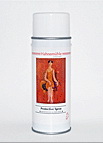A previous post on this blog talked about Clearcoating Inkjet Photo and Art Prints and LexJet’s Sunset Gloss and Sunset Satin Coatings. It was noted that LexJet Sunset Coatings can be applied with either a spray gun or foam roller. Below are a few tips for using a foam roller to apply a smooth, even coating.
Note that the effectiveness of these techniques may vary depending on the humidity and temperature of your working environment. It may take a little practice and experimentation to find the touch and technique that works best for your studio.
1. Start with a high-density, white foam roller and a tray that is typically used for holding paints. You can buy these products in the paint department of any home-improvement store. The high-density foam will help reduce bubbles. Use a larger-width roller if you plan to coat larger canvases.
2. Pour the coating into the tray and dip the roller in the coating until it is thoroughly wet, but not too wet.
3. Lay your print on a clean, dust-free board that is bigger than your print. The extra space on the surface around the print can be used to roll off excess liquid if you happen to oversaturate the roller.
4. Consider using two or three thinner coats, instead of one thicker coat.
5. Don’t try to coat the whole print at once. Start with one or two passes at the edge of the print, and go over each pass enough times for the bubbles to dissipate, but not so many times that the coating becomes tacky or bumpy.
6. If large bubbles appear, try blowing on the coating.
7. Make overlapping passes so you can maintain a wet edge and avoid lines and streaks.
8. Find the rolling pattern that works best for you. Some users prefer rolling in one direction only. They go up the print in one pass, and down the print in the second pass (like mowing a lawn). Others will apply enough coating at once to roll it out in a few different directions until the excess rolls of the side. They then roll smooth passes, alternating horizontal and vertical passes. While the coating is still wet, they use the side of the roller or a brush to smooth the coating on the edges of the stretched canvas print.
9. Don’t press down on the roller. Maintain a light, even pressure.
10. If you are applying a second coat, allow the first coat to dry before applying the second coat. A thin coat should take about five minutes to dry. But it will take longer if you’re working in an environment with high humidity.
11. Allow the coated print to dry thoroughly before you pack it for shipping. Don’t try to speed up the drying process with a fan; allow the print to dry on its own.
12. Clean the rollers immediately after each use. Run cool water of the rollers immediately after use, and squeeze them until they run clear. Allow 10 to 15 minutes. If you keep the rollers clean, you can use them for about six months before you need to replace them.
If you have any questions about how to apply Sunset Coatings, please contact a LexJet account specialist at 800-453-9538.
Filed under: Inkjet Print Protection, Uncategorized | Tagged: canvas printing, clearcoating canvas, fine art printmaking, giclee printing, Sunset Coatings | Leave a comment »





